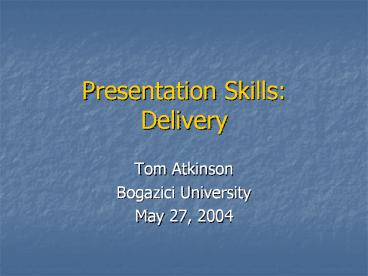Presentation Skills: Delivery - PowerPoint PPT Presentation
1 / 35
Title:
Presentation Skills: Delivery
Description:
Title: Effective Presentations Skills Author: CARTER Created Date: 6/17/2003 3:14:38 PM Document presentation format: On-screen Show Company: ETSU Other titles – PowerPoint PPT presentation
Number of Views:72
Avg rating:3.0/5.0
Title: Presentation Skills: Delivery
1
Presentation Skills Delivery
- Tom Atkinson
- Bogazici University
- May 27, 2004
2
Agenda
- Motivation
- Presentation Process
- Presentation Techniques
- Practice
3
Part 1Motivation
4
A fear worse than death
- Speaking is peoples biggest fear. Death is
number 2. In other words, you would rather be in
the coffin than giving the eulogy. - - Jerry Seinfeld
5
Causes of Anxiety
- Fear of the unknown
- Being unprepared
- Having no enthusiasm
- No focus of attention
6
The secret to success
- Be passionate
- Prepare
- Practice
7
Part 2Presentation Process
8
As with everything, theres a process
- Before the Big Day
- Write the presentation
- Know what to expect
- Practice
9
Getting Started
- Set up 30 minutes prior
- Put up title slide 5 minutes prior
- Welcome and talk to members of audience
- Helps create a connection
- Relaxes you
- Tell audience if you want questions during or
after
10
Giving it
- Give prepared introduction
- Keep it short and simple
- Speak 2-3 minutes / slide
- Too quick, audience gets lost
- Too slow, audience gets bored
- Give prepared conclusion
- Take final questions
11
Use Transitional Sign Posts
In summary
however
- Forecast next idea
- Emphasize relationships
- Give audience time to digest material
- Give speaker time to think about next point
once again
finally
12
Transition Example
Transition Now that we have some theoretical
basis for this research
Internal Summary Id like to discuss the
following 3 commercial applications
13
Closing guidelines
- Summarize the main points
- Leave them with the main thought that you want
them to remember - Thank the audience
14
Handling Questions
- If you dont know the answer
- Acknowledge it is a good question
- Indicate you dont have the answer
- Say you will find the answer and get back
- DONT try to bluff
- DO get back
15
Handling Questions
- If one person is asking too many questions
- Give a complete, but short answer
- Ask to take the conversation off-line
- Move on
16
Part 3Presentation Techniques
17
Remember this?Messages do not reach the
receiver due to distortion
Feedback
Sender
Receiver
Distortion
18
Your want to avoid this situation
Source United Behavioral Health
19
Clear the distortion with
- Effective delivery
- Natural, engaging body language
- Know the equipment
- Good knowledge of space
20
1. Effective Delivery
- Be natural
- Avoid difficult, technical language
- Avoid jargon
- Speak a little slower than normal
- Be obvious
- Do not assume audience understands implications
- Avoid inside jokes
- Be punctual
- Finish on time or before
21
Vocal variety
- Vary the pitch and volume of your voice.
- Use inflections to emphasize critical points
- Avoid reading your presentation
- Avoid memorizing your entire presentation
22
Common Problems
- Verbal fillers
- Um, uh, like
- Unrelated words or phrases
- Swaying, rocking, and pacing
- Hands in pockets
- Lip smacking
- Fidgeting playing with your pen
- Looking away from the audience
23
Caution!
- Only use anecdotes that are relevant
- Use caution with personal experiences
- Stay away from inappropriate humor
24
2. Natural, Engaging Body Language
- Show enthusiasm
- S p e a k s l o w l y a n d c l e a r l y
- Project to fill the whole room
- No Ummms or ahhhhs
Pleasant grin
Feet firmly planted, square with shoulders
Clean-cut, pleasant dress
25
Sources of Noise
- Dont distract your audience by
- Wearing a hat
- Wearing sunglasses
- Chewing gum or tobacco
- Using note cards use the screen instead
- Using gender bias or stereotypical terms
- Being negative and apologizing
26
3. Know the Equipment
- Using your own laptop
- Screen savers
- Video and sound output, volume, lighting
- Using the schools computer
- PowerPoint may replace bullets and fonts
- Demos
- May require a certain network, internet, a
particular version of an OS, non-standard dlls,
video card settings
27
4. Know the Space
- Visibility
- Movement
- Number of seats
- Seating arrangement
- Distracters
28
Handouts only if required
- Distribute handouts
- At end if possible
- At beginning only if audience needs them during
presentation - Not during
- Print one-sided, with 2, 3 or 6 to a page
- Staple beforehand
29
Summary Your presentation will be great if you
make it
- Audience centered
- Accomplish your objective
- Fun for the audience
- Fun for you
- Finish within the time frame
30
How do you do this? With
31
Part 4Practice
32
How to Practice
- In front of the mirror
- With a friend
- In the actual room where you will give the
presentation - In front of a video camera, with a friend, in the
actual room where you will give the presentation
33
Lets Practice!
- Any volunteers?
34
Communications Seminar SummaryWhat do you
remember about
- Listening?
- Email writing?
- Report writing?
- Presentation preparation?
- Presentation delivery?
35
Thank You!































